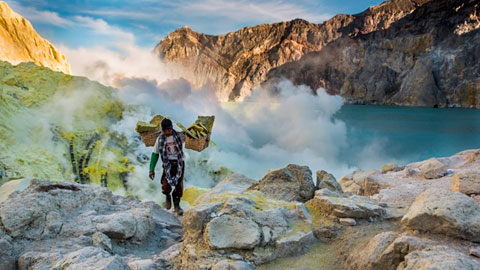Mapping out the impacts of pollution upon indigenous peoples worldwide

An international study including the involvement of the Institute for Environmental Science and Technology of the UAB (ICTA-UAB) compiles all existing information on the exposition and vulnerability to environmental pollution by indigenous peoples, as well as the impacts of this pollution on communities around the world.
Mineral extraction, both at an industrial and artisanal level, is the main source of pollution of the lands inhabited by indigenous peoples. This pollution impacts their health through consumption of contaminated food and water, including wild foods obtained through hunting, fishing, and gathering.
This is the main conclusion of an international scientific study involving the Institute of Environmental Science and Technology from the Universitat Autònoma de Barcelona (ICTA-UAB), which presents the current state of knowledge on the exposure and vulnerability of indigenous peoples to environmental pollution. The study also reviews the innumerable impacts that pollution poses on indigenous communities all around the world.
The study, recently published in the journal Integrated Environmental Assessment and Management, was led by the University of Helsinki, and included the collaboration of Joan Martinez Alier and Victoria Reyes García, both from the ICTA-UAB. "While the number of studies examining the impacts of environmental pollution upon indigenous peoples is growing, most of this research is isolated and fragmented across disciplines and geographic regions", says Dr. Álvaro Fernández-Llamazares, from the University of Helsinki and main author of the study. He adds that "in fact, few efforts have cut across disciplinary topics and/or regions, and until today there was no global review mapping out the worldwide impacts of environmental pollution on indigenous peoples".
The study, which reviewed more than 680 different publications and the database of the Atlas of Environmental Justice (EJATlas) coordinated by the ICTA-UAB, analyses all the documented impacts of environmental pollution among indigenous groups from all inhabited continents. The study revealed that pollutants accumulating in food chains through biomagnification have been particularly well‐documented in marine animals, many of which are central to the diets of several indigenous communities. Authors discovered that, because activities associated with collecting wild(?) foods generally serve important community roles, concerns associated with pollution regarding the consumption of wild foods can also impact these practices. Thus, pollution can result in fear of consuming traditional wild foods, and foster increased reliance on nutrient‐poor and expensive market foods, often increasing the risk of malnutrition and chronic diseases.
"All the literature reviewed provides clear evidence that indigenous peoples are largely and heavily affected by polluting activities through both their exposure and vulnerability, and that much of this pollution is linked to broader patterns of colonization", says Fernández-Llamazares. "However, we also note that, all over the world, indigenous peoples are developing innovative strategies to limit, abate or stop ongoing pollution and fighting to prevent it from its outset".
The literature review documents several pathways in which indigenous peoples are contributing to bringing pollution to levels that are not detrimental to human health or to ecosystem functioning. Such strategies include social mobilization, blockades, cultural resistance camps, global policy advocacy litigation processes to hold pollutants into account or participatory monitoring, among others.
"I was particularly inspired by the numerous examples where indigenous communities and scientists have built successful partnerships to martial global support for the defence of
environmental justice", says Fernández-Llamazares He adds, "it is my hope that this review will contribute to bring visibility to the arduous efforts of the many indigenous communities that are fighting to combat pollution all over the world."
Original paper:
Fernández-Llamazares Á, Garteizgoeascoa M, Basu N, Brondizio ES, Cabeza M, Martínez-Alier JM, McElwee P, Reyes-García V. (2020) A State-of-the-Art Review of Indigenous Peoples and Environmental Pollution. Integrated Environmental Assessment and Management 16(3): 324-341. doi: https://doi.org/10.1002/ieam.4239
Photo: Sulphur mine at Ijen, Java, Indonesia. Author: Joan de la Malla.






